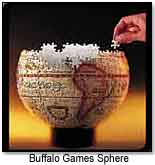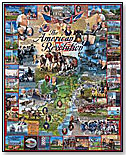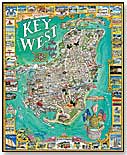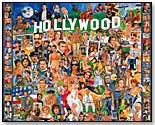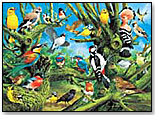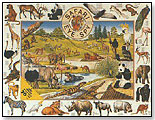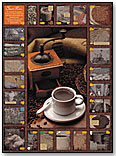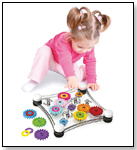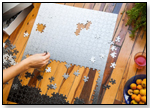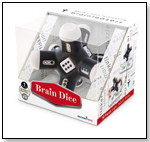|
|
Traditional Puzzles: More Than Meets the Eye Not Hip or Trendy, Traditional Puzzles Still Find a Loyal Audience
“For every puzzler that looks for the maze or the mystery or the double-sided, there are those that simply want a traditional puzzle to fill the dining room table and share with family and friends,” Renaud said. And the only way to make a traditional puzzle stand out from every other one on the store shelf is with a memorable image. Milton Bradley is having an online vote to let customers choose the next images for three of their 1000-piece puzzles to be released this June. But how do most companies choose images they know their customers will enjoy? They generally select scenes via two sources: already available artwork and in-house development. Companies often return to the same artist or licensor, such as Norman Rockwell or Audubon, because they are popular with puzzle fans. “Puzzle people like to make collections,” wrote Julie Wilkin, co-director of James Hamilton Grovely Puzzles Ltd., “so we try to use this when we think about images.” Unfortunately, since popular artists can license to multiple companies, puzzles from different companies can start to resemble each other. According to Renaud, Buffalo Games searches for unique puzzle images with a proven track record by sometimes selecting “subjects that have proven themselves in other consumer goods, be it calendars, textiles, prints, etc.” They also consider longevity of an image’s popularity. For instance, they usually gravitate toward classic Disney characters as opposed to those in more recent movies. In-house development helps puzzle companies distinguish themselves from all the other companies. Companies create their own niche in the market by developing unique series such as White Mountain Puzzle’s series The American West and American Lighthouses. Cronan Minton, partner of White Mountain Puzzle, described how they avoid cookie-cutter images: “We invite them [freelance artists] to also participate in the decisionmaking process and suggest ideas … we try to stimulate each other and come up with winning ideas.” Not every idea, however, fits every artist. Although Randy Green, a history buff, creates fun and educational history puzzles such as The American Revolution, he could never design the puzzles made up of more than 150 miniature portraits that Jim Mellet is responsible for. Minton admits that there is less risk, both in time and money, when licensing generic images but said the returns rarely compare to those for the puzzle topics they develop. Another advantage of in-house development is the ability to tweak the difficulty level of a puzzle in the rough draft stage. Wilkins explained that when they review an artist’s rough draft, “we can incorporate difficult bits in the background, like tree branches in the European Birds Puzzle, and also in the puzzle subjects. We have a new puzzle that is all British native horse and some of the pony colors are similar.” In reality, puzzles haven’t changed since they were first created in the mid-1700s. And neither have the people who love puzzles. Renaud dismisses the search for the next trend in puzzles instead describing puzzlers as people interested in “a quality product that produces the proper mix of challenge and enjoyment.”
 Writer's Bio: The mother of three children ages 13, 10 and 2, Jodi Webb started out as a toy seller. She´s happy to find a job where her accountant will let her write off her toy purchases! Read more articles by this author Writer's Bio: The mother of three children ages 13, 10 and 2, Jodi Webb started out as a toy seller. She´s happy to find a job where her accountant will let her write off her toy purchases! Read more articles by this author |
| |||||||||||||||||||||||||||||||||||||||||||||||||||||||||||||||
Disclaimer Privacy Policy Career Opportunities
Use of this site constitutes acceptance of our Terms of Use.
© Copyright 2025 PlayZak®, a division of ToyDirectory.com®, Inc.

